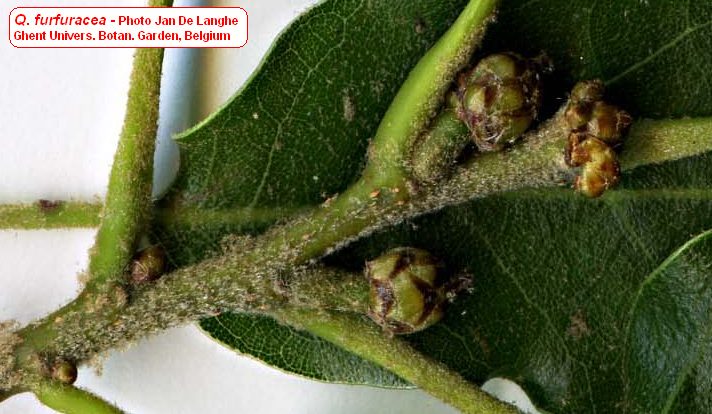| Quercus furfuracea | |
| Author |
Liebm. 1854 Overs. Kongel. Danske Vidensk. Selsk. Forh. Medlemmers Arbeider 1854: 189 Diagnosis here |
| Synonyms | acutifolia var.
furfuracea (Liebm.) Oerst. 1869 |
| Local names | |
| Range | Mexico, Sierra
Madre Oriental (Puebla, Hidalgo, San Luis Potosi) ; |
| Growth habit | 8-15 m tall; |
| Leaves | 4-12
cm x 2.5-5; deciduous; thick, stiff, coriaceous; elliptic to ovate or
lanceolate; apex pointed, bristle-tipped; base rounded, cuneate or truncate;
margin not or very slightly revolute, mostly flat, often slightly crispate,
with 3-10 pairs of aristate teeth (teeth 4 mm long) in the 2/3 or 3/4
of the blade; shiny olive green above, with long stellate multiradial
hairs along midrib, and short ones on the limb; at first densely greyish
floccose pubescent beneath, then the stellate trichomes detach from the
blade, into kinds of squames, leaving axil tufts; 6-9 vein pairs, parallel,
flat adaxially, prominent beneath; epidermis papillose or smooth; petiole
1-2.5 cm long, yellowish, densely floccose, glabrescent; |
| Flowers | pistillate catkins
1-2 cm long, with 1 to several flowers; |
| Fruits | acorn ovoid
1 cm long, singly or paired on a 1-2 cm long peduncle; cup half-round
with pubescent scales enclosing 1/2 the nut; maturing in 1 year in September;
|
|
Bark, twigs and |
twig
1-3 mm in diameter, reddish-brown, with dense yellowish floccose pubescence
lasting several seasons, and with inconspicuous lenticels; bud ovoid 2.5-4
mm long, reddish, lustrous, obtuse, with pubescent scales; |
| Hardiness zone, habitat | |
| Miscellaneous | --
A. Camus : n° 386; -- Sub-genus Quercus, section Lobatae, sub-section Acutifoliae; -- Threatened (IUCN Red List Category : VU). -- Possible confusion with Q. meavei as both have a fulvous tomentum on twigs and petiols, but meavei has nearly glabrous, wider leaves (to 7 cm), longer teeth (2 to 8 mm), 14-19 veins pairs, and the fruit is biennial; -- Ressembles Q. sartorii but can be distinguished by its floccose twigs, petiole and veins, while sartorii has twigs, petiole and veins glabrous or glabrescent; |
| Subspecies and varieties |
|
| Pictures |
More pictures HERE
|



